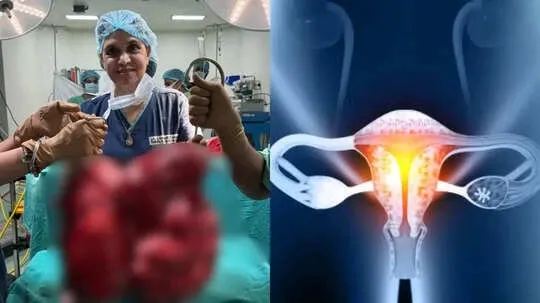Doctors Remove Enormous 18.5 Kg Fibroid from Woman’s Uterus, Nearly the Weight of 5 Newborn Babies; What Causes It?
admin | August 11, 2025 9:23 PM CST

Doctors from a Delhi hospital successfully removed a massive, almost 20-kilogram fibroid from the uterus of a woman. The patient, a 56-year-old woman, had been silently suffering for nearly six years with multiple fibroids - one of which had expanded her abdomen to an enormous size, leading to extreme discomfort in day-to-day activities, restricting her mobility, and causing pain and pressure on surrounding organs.
"This patient had a massive tumour in her uterus. It was more complex and larger than we anticipated from her pre-surgical scans. Meticulous planning was needed pre-operatively for the surgery. Cases like this highlight the importance of strong teamwork, as such cases often demand real-time decision-making and on-the-spot planning that cannot always be anticipated beforehand," said Dr Dinesh Kansal, Senior Director and Head - Obstetrics and Gynaecology and Laparoscopic Surgery, BLK Max Super Speciality Hospital, who led a multidisciplinary team from urology, anaesthesia, and critical care.
"The benign fibroid had grown so large that the mammoth uterus was pressing against nearby organs, including the intestine, bladder, and ureter. Her internal anatomy was severely distorted, and key organs were closely adherent to the fibroid. The patient also had internal scarring from previous surgeries, which made the procedure more complex," she added.
Dr Kansal said the surgery lasted several hours, and the patient's condition was closely monitored throughout. She was discharged on the fourth day and has now recovered while resuming a comfortable and active lifestyle.
What are uterine fibroids?
Uterine fibroids, also known as leiomyomas or myomas, are noncancerous or benign growths that develop in the uterus. Experts say they are very common, especially during the childbearing years, and can vary in size and number. While many women with fibroids experience no symptoms, others may have heavy or prolonged menstrual bleeding, pelvic pain or pressure, and other issues.
Fibroids can grow as a single nodule or in a cluster, ranging in size from 1 millimetre to more than 20 centimetres in diameter or even larger. For comparison, fibroids can be as small as a seed or as large as a watermelon. These growths can develop within the wall of your uterus, inside the main cavity of your uterus, or on the outer surface of your uterus.
According to experts, fibroids are a very common type of growth. Approximately 40 to 80 per cent of women with a uterus have fibroids. They occur most often in people between 30 and 50 years old. Those who have not had their first period yet typically do not have fibroids. They are also less common in people who have entered menopause.
Signs and symptoms of uterine fibroids
Most of the small fibroids do not cause any symptoms and do not require treatment except regular observation by the doctor. However, larger ones can cause you to experience a variety of symptoms, including:
- Pain and excessive bleeding
- Bleeding between your periods
- A feeling of fullness in your lower belly
- Frequent urination
- Pain during sex
- Lower back pain
- Constipation
- Long-term vaginal discharge
- Inability to pee or completely empty your bladder
- Increased abdominal enlargement
- Obesity and being overweight
- Family history of fibroids
- Not having children
- Early onset of menstruation
- Late age for menopause
READ NEXT
-
Germany invites Trump, Zelenskyy, NATO, EU leaders to virtual meeting before Trump-Putin summit

-
She fell in love with cycling at 50, now at 87, she has completed 200 triathlons and countless races. Here’s her fitness secret

-
Disney+ cancels Goosebumps series after two seasons: What’s next for the horror anthology?

-
Ford’s expansive EV puzzle: $5 billion investment and new T model — new race to counter China finally begin?

-
US stock market today: Dow, S&P 500, and Nasdaq face key week that could shape summer rally
